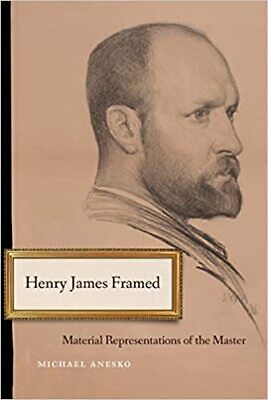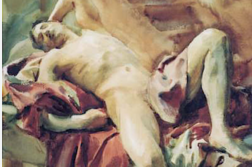 HENRY JAMES FRAMED
HENRY JAMES FRAMED
Material Representations of the Master
by Michael Anesko
Univ. of Nebraska. 224 pages, $60.
HENRY JAMES believed both the novelist and the painter should “compete with life.” James competed by delineating the ways in which ruthless psychological and social forces determined the fate of his characters, an insight that permanently secures his place as a major American novelist. Studies of James can be as daunting as his own late novels. This book is an exception. Michael Anesko has dedicated a prodigious amount of scholarship to produce an accessible, highly entertaining account of the 24 times that James sat for his portrait. He tells the story behind each occasion, describes the results in nontechnical language, and traces the provenance of each work. This is a book for anyone interested in Henry James and cultural objects associated with him.
James sat for his first portrait in 1877, when he was 21 years old. The artist was John La Farge, whom Henry and his brother William met in an art class. Near the end of his life, James would recall the summer afternoons he sat for LaFarge as “insistently romantic.” For his part, LaFarge recognized that Henry had more talent with the pen than the brush and told him so. Befitting the youth of both subject and artist, the portrait is the most sensuous of all the representations of James.
What Anesko calls the “Queer Provenance” of the painting makes for a great story about a married heir to the Singer sewing machine fortune and his closeted relationships with two young men. One, a sculptor whose work was decidedly homoerotic, resembles Hendrik Andersen, the young sculptor with whom James became romantically involved when he was almost sixty. Andersen produced an uninspired bronze bust of James in 1907 that still resides in the dining room of Lamb House, James’ residence in Rye in East Sussex, England, now part of the National Trust. When they were discovered in the 1950s, James’ letters to Andersen provided convincing evidence of his attraction to young men—so convincing that twenty years earlier the James family had tried to suppress them.

As James’ reputation grew, artists sought him out, hoping he would agree to sit for a portrait. James usually said Yes. Anna Lee Merritt, a young artist from Philadelphia living in London, aspired to paint portraits of “the greatest men of my generation.” Anesko notes that prior to the 20th century, female artists could not study with the best teachers and certainly not in studios with nude models. They could compete with men for portrait commissions, but the subjects they secured were usually families, not public figures. Like a Jamesian heroine, Merritt persisted in her aspirations, and in 1889 she completed a portrait of James, having earlier done James Russell Lowell and Oliver Wendell Holmes. The story comes to an ironic conclusion when we learn that “the whereabouts of the original painting remains unknown” (though an engraving survives).
Careers in art ran in the James family. He was painted by three relatives, his nephew Billy and two cousins, Ellen and Jane Emmet. The chapters on these works reveal the affection James felt for his young relatives and their fond amusement at his “finicky habits of speech” and odd table manners. No one, including the artist, considered the portrait by Billy a success. It was done in 1911 when James, who was not well, had returned to America with his ailing brother William, who died soon after they arrived. Ellen Emmett painted her cousin in 1900 at Lamb House. Hers is the first portrait of James without the beard he had sported for three decades. After the author’s death, the James family kept the portrait. In 1968, a dissolute great-nephew, disliking the painting, gave it to James’ biographer Leon Edel, who discovered a second portrait, a sketch of the finished work, hidden behind the canvas—a denouement worthy of James. Both paintings now hang in the National Portrait Gallery.

Only one representation of Henry James is considered to have great value aside from its association with the author. This, of course, is the masterpiece painted by John Singer Sargent in 1913, three years before James died. A group of friends, wanting to celebrate his seventieth birthday, raised funds for the painting through a subscription. At first, the very private James was bothered by the idea of a public subscription, but eventually appeals from friends—particularly from a woman confidant he had known for years—caused him to change his mind. James and Sargent had been close friends for decades. Both were famous, both were lifelong bachelors, both had devoted relationships with other men. James considered the portrait “a very fine thing indeed.” More than any of the artists who portrayed James, Sargent had psychological insight into the character of his subject. The painting received immediate acclaim. Before it was hung in the National Portrait Gallery in London, Sargent’s portrait was exhibited in San Francisco and Boston, returning to England in 1916 on a ship that, two years later, would be torpedoed by a German U-boat.
Some of the portraits discussed in this book had a second life when the Henry James revival took off in the 1960s, and images of the Master appeared on paperback editions of his works. Henry James Framed is a beautifully produced book. The illustrations are first-rate, and the design allows for easy access to footnotes. Many readers skip footnotes, but Michael Anesko, a professor at Penn State, writes with such wit and clarity, it would be a mistake not to dig further into the delights he has served up in this book.
Daniel Burr, a frequent G&LR contributor, resides in Covington, Kentucky.




